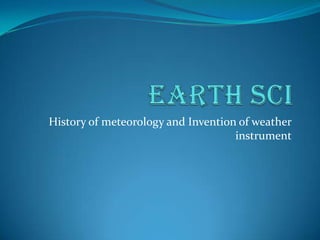
2nd activity
- 1. Earth sci History of meteorology and Invention of weather instrument
- 3. History of meteorology: In 350 BC, Aristotle wrote Meteorology.[3] Aristotle is considered the founder of meteorology.[4] One of the most impressive achievements described in the Meteorology is the description of what is now known as the hydrologic cycle.[5] The Greek scientist Theophrastus compiled a book on weather forecasting, called the Book of Signs. The work of Theophrastus remained a dominant influence in the study of weather and in weather forecasting for nearly 2,000 years.[6] In 25 AD, PomponiusMela, a geographer for the Roman Empire, formalized the climatic zone system.[7] Around the 9th century, Al-Dinawari, a Kurdish naturalist, writes the Kitab al-Nabat (Book of Plants), in which he deals with the application of meteorology to agriculture during the Muslim Agricultural Revolution. He describes the meteorological character of the sky, theplanets and constellations, the sun and moon, the lunar phases indicating seasons and rain, the anwa (heavenly bodies of rain), and atmospheric phenomena such as winds, thunder, lightning, snow, floods, valleys, rivers, lakes, wells and other sources of water.
- 4. Meteorologists are scientists who study meteorology.[51] Meteorologists work in government agencies, private consulting and researchservices, industrial enterprises, utilities, radio and television stations, and in education. In the United States, meteorologists held about 9,400 jobs in 2009.[52] Meteorologists are best-known for forecasting the weather. Many radio and television weather forecasters are professional meteorologists, while others are merely reporters with no formal meteorological training. The American Meteorological Society and National Weather Association issue "Seals of Approval" to weather broadcasters who meet certain requirements. The word 'meteorology' was coined from a research book called 'Meteorologica' which was written by Aristotle, a Greek scientist and philosopher. This early work described the science of earth like its geology, elements, hydrology, seas, wind and weather. In the modern term, the term meteorology explains a complete science. It is for understanding the dynamics of atmosphere and forecasting weather phenomena like hurricanes and thunderstorms.
- 5. Weather forecasting was practiced since the beginning of time with more or less accuracy. Historical records show several examples of weather predicting methods based on observing surrounding elements. Sky is undoubtedly the first indicator used in meteorology its cover and nature of clouds provides clues of the upcoming temperature and weather. The wind factor is also important and is associated with temperature and often rains. Animals and birds are also known to give indications about the future weather. Scientists across the world since ancient times have tried to understand the meteorological phenomena like wind and rain. Many instruments for measuring wind power, humidity and rain were invented in the early 15th century. During the 17th century, several discoveries tipped in favor of scientific meteorology. A device to measure temperature was invented by Galileo Galilei and the factor that atmospheric pressure was linked to altitude was discovered by Blaise Pascal. The invention of barometer by Evangelista Torricelli is significantly the most important discovery. It is still in use today which indicates atmospheric pressure changes that are linked with the future weather changes. There are also other methods which have been evolved. Meteorology is a lot related with cycles and their analysis which was what Fernando II de Medici wanted to prove. He carried out a very determined program in 1654 for recording weather patterns in different European cities with a view to compile data and make their analysis. Other breakthroughs were followed in the 18th century and science was taken to a new level. A modern mercury based thermometer was invented by Gabriel Fahrenheit.
- 6. Invention of weather Instrument
- 7. Instruments and equipment of meteorology: Nephelometer – an instrument used to measure suspended particulates in a liquid or gas colloid. Gas-phase nephelometers are used to provide information on atmospheric visibility and albedo Nephoscope – an instrument for measuring the altitude, direction, and velocity of clouds Pyranometer – A type of actinometer found in many meteorological stations used to measure broadband solar irradiance Radar – see Weather radar Radiosonde – an instrument used in weather balloons that measures various atmospheric parameters and transmits them to a fixed receiver Rain gauge – an instrument that gathers and measures the amount of liquid precipitation over a set period of time Snow gauge – an instrument that gathers and measures the amount of solid precipitation over a set period of time SODAR (SOnic Detection And Ranging) – an instrument that measures the scattering of sound waves by atmospheric turbulence Solarimeter – a pyranometer, an instrument used to measure combined direct and diffuse solar radiation Sounding rocket – an instrument-carrying sub-orbital rocket designed to take measurements and perform scientific experiments
- 9. Stevenson screen – part of a standard weather station, it shields instruments from precipitation and direct heat radiation while still allowing air to circulate freely Sunshine recorders – devices used to indicate the amount of sunshine at a given location Thermograph – a chart recorder that measures and records both temperature and humidity Thermometer – a device that measures temperature or temperature gradient Weather balloon – a high-altitude balloon that carries instruments aloft and uses a radiosonde to send back information on atmospheric pressure, temperature, and humidity Weather radar – a type of radar used to locate precipitation, calculate its motion, estimate its type (rain, snow, hail, etc.) and forecast its future position and intensity Weather vane – a movable device attached to an elevated object such as a roof that shows the direction of the wind Windsock – a conical textile tube designed to indicate wind direction and relative wind speed Wind profiler – equipment that uses radar or SODAR to detect wind speed and direction at various elevations
- 10. Prepared by: Janine O. Baleza
- 11. End